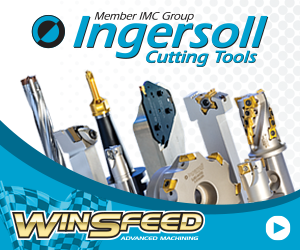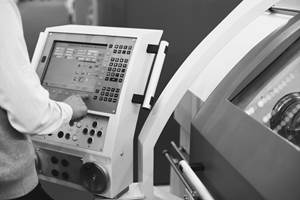3 Task Simplifications That Reduce Production Time
A little ingenuity goes a long way toward improving machine utilization.
Share





There are only two task categories related to running a CNC: making setups and running production. In similar fashion, there are only two types of tasks involved with each: online (internal) tasks, which add to machine usage time, and off-line (external) tasks, which do not. Accordingly, setup time or production run time is the total of all online tasks.
There are three main ways to reduce setup or production run time: eliminate tasks, move tasks offline or facilitate (simplify) them. While eliminating tasks or moving them offline commonly require large investments, simplifying tasks often requires little more than time and effort. The idea is that if a task is easier to perform, it can be done faster by a person with a lower skill level, and with less possibility for mistakes.
A little ingenuity can go a long way toward improving machine utilization. Simply determine where your CNC people are struggling and find ways to help them. Below are three task-simplifying suggestions that improve CNC machine utilization. Emphasis is placed on return on investment, meaning very little, if any, cash investment is required to achieve large benefits.
Become Better Organized
Organization is the foundation for any improvement program. Indeed, the first step to improving anything is often to get better organized. Good organization makes it easier to perform any task. Organization affects everyone, including setup people and operators. Some suggestions include:
- Work benches should be kept clean and free of clutter.
- Every hand tool needed on a regular basis should have a place and should always be in that place.
- Any time you see a CNC person leave their work areas to collect a needed item, consider keeping that item in the work area.
- The area around the work bench should be kept clear.
Provide Everything Needed to Make Sizing Adjustments
This suggestion is aimed primarily at CNC operators, especially entry-level operators, but even experienced setup people can benefit. Sizing adjustments require the CNC person to compare a measured value to the tolerance specification and determine if the measured workpiece attribute is nearing a tolerance limit. If it is, a calculation must be made to determine the amount and polarity of the adjustment. Then the appropriate offset register must be adjusted.
This can be very challenging to entry-level operators — and there are two simple things you can do to simplify it.
- Provide all needed tolerance values. Design engineers provide tolerance specifications in a variety of ways. Some are easier to interpret than others. And they don’t provide the target value (often the mean value). Eliminate this inconsistency and the related calculations by providing the high limit, low limit and target value of every critical workpiece attribute. My suggestion would be something like 5.005"/5.0"/4.995" for a 5.0"±0.005" tolerance specification, assuming that the mean value is to be the target value. This can be done on a marked-up engineering drawing or with some other form of process documentation.
- Relate the workpiece attribute being measured to the offset number and register that must be adjusted. While setup people know which cutting tool machines each critical surface because they loaded the cutting tools, CNC operators will not. One way is to use a marked-up engineering drawing, highlighting each finished surface with a different colored pen. A color code chart can specify which offset and register is related to each color.
Program the Task of Trial Machining
This suggestion is especially important to CNC setup people but it can also help CNC operators if they must replace dull tools during a production run.
Trial machining is done when it is crucial that the first workpiece produced in a job be a good one. The setup person machines the first workpiece as part of program verification during setup. As the setup person comes to each critical finishing tool, they consider what the tool will be doing.
If it is machining a surface with a small tolerance, and if they are worried the cutting tool’s initial (program zero setting) adjustment is not precise enough to ensure that the surface will be machined within tolerance specification on the first try, they will cause the cutting tool to machine the surface with extra material. They will stop the cycle when the tool is finished and measure the surface. They will then measure to determine how much extra stock is on the surface, adjust the appropriate offset register accordingly, and rerun the cutting tool. This ensures that the cutting tool will correctly machine the surface even for the first workpiece. If this is done for all critical machining operations, the first workpiece will be a good one.
If critical surfaces require trial machining during setup, then they will require it when dull tools are replaced during production runs, meaning CNC operators must also be able to perform the trial machining process.
If a setup person or operator can determine when trial machining is required, then a programmer should also be able to. Using some special features of programming, like block delete, program stop (M00) and/or custom macro commands, the programmer can specify the motions and functions needed for trial machining right in the program. The block delete switch can, for instance, be used to tell the machine whether trial machining is required or not. This limits what the setup person must do to activating the switch, measuring when the tool is finished, and adjusting the appropriate offset register.
Related Content
The Best Point of Reference for Program Zero Assignment Entries
Correctly specified program zero assignment and coordinate position values enable the CNC to determine how far to move the cutting tool during each positioning motion.
Read MoreObscure CNC Features That Can Help (or Hurt) You
You cannot begin to take advantage of an available feature if you do not know it exists. Conversely, you will not know how to avoid CNC features that may be detrimental to your process.
Read More4 Commonly Misapplied CNC Features
Misapplication of these important CNC features will result in wasted time, wasted or duplicated effort and/or wasted material.
Read MoreHelp Operators Understand Sizing Adjustments
Even when CNCs are equipped with automatic post-process gaging systems, there are always a few important adjustments that must be done manually. Don’t take operators understanding these adjustments for granted.
Read MoreRead Next
2025 Top Shops Benchmarking Survey Now Open Through April 30
Modern Machine Shop's Top Shops Benchmarking Survey is now open, offering metalworking and machining operations actionable feedback across several shopfloor and business metrics.
Read MoreSetting Up the Building Blocks for a Digital Factory
Woodward Inc. spent over a year developing an API to connect machines to its digital factory. Caron Engineering’s MiConnect has cut most of this process while also granting the shop greater access to machine information.
Read MoreShop Tour Video: You've Never Seen a Manufacturing Facility Like This
In the latest installment of our “View From My Shop” series, explore Marathon Precision’s multi-process approach to manufacturing, where blacksmiths and hand-forged dies meet state-of-the-art CNC machining. Discover how restoring classic muscle cars and building custom art projects creates a dynamic shop culture — and draws top talent to this unique and innovative metalworking facility.
Read More
.jpg;width=70;height=70;mode=crop)


















.png;maxWidth=300;quality=90)


_Network-Zone_TAP-300x250-Final.jpg;maxWidth=300;quality=90)








